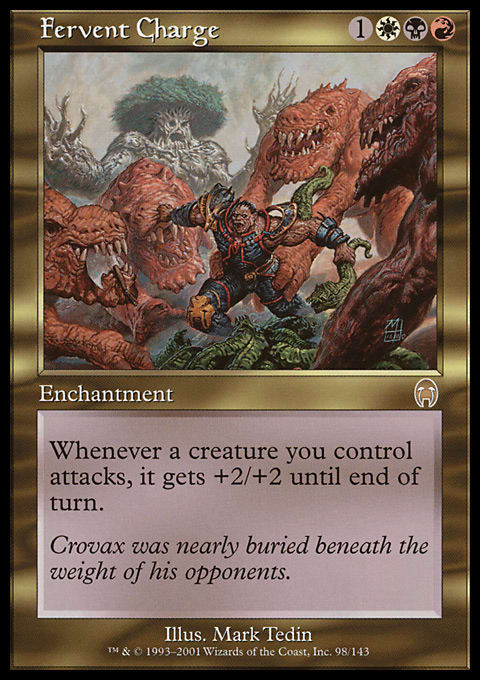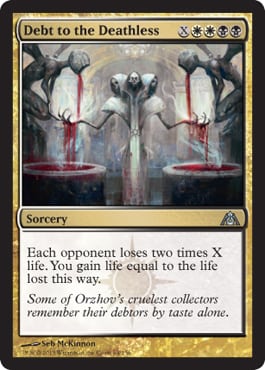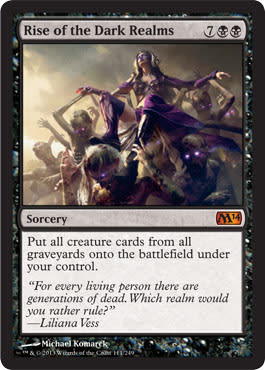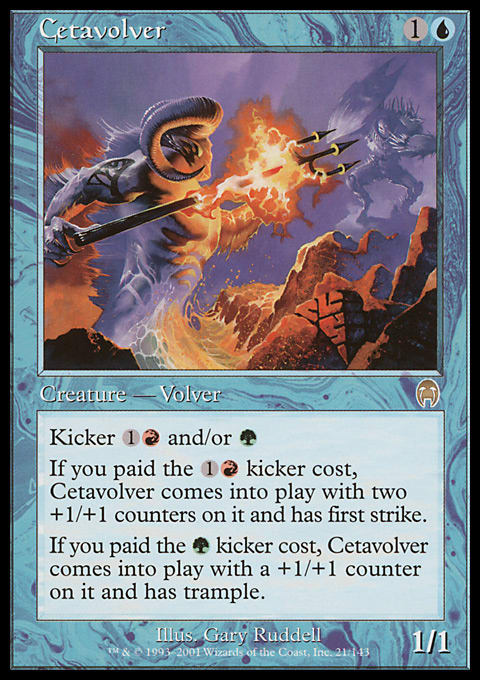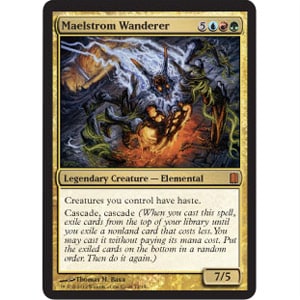Graveborn Musings
Wedge World! Wedge World! Party time! Excellent!
I’ve been too busy playing Magic to write about it recently, but then Wizards dropped the bomb at Comic-Con that Khans of Tarkir is going to be the set of my dreams, and now my Magic boner is bigger than ever. Today, I’m going to take a look at what this set is likely to mean for Commander players, with my trademark blend of insightful analysis, unfounded speculation, and casual obscenity.
But maybe I’m getting ahead of myself; time for an exposition scene . . .
Exposition Scene
Back in Planar Chaos, Wizards did something they’d never done before: They made legendary creatures in three, non-aligned colors with the third cycle of the so-called Elder Dragons. They were:- Teneb, the Harvester (B/G/W)
- Vorosh, the Hunter (G/U/B)
- Numot, the Devastator (R/U/W)
- Oros, the Avenger (W/B/R)
- Intet, the Dreamer (U/R/G)
These color combinations (one color and its two opposites) are called wedges—to connect those dots on the color pie, you have to draw a wedge shape.1
This was right about the time I started to get into EDH (as it was called then), and so my first three generals (as they were called then) were Teneb, Vorosh, and Numot. There wasn’t a lot of three-colored love, as they had only made wedge cards in one other set: Apocalypse, way back in 2001. Because of the lack of cards or a defined identity, it was hard to know where to start building a wedge deck, beyond just generically smooshing three guilds together.
So, when they introduced wedge-colored legends in the Commander 2011 set, everyone was thrilled; they gave us a lot more deck-building options, and at least in some cases, they helped us to see a clearer identity for each wedge. However, part of me was sad that they only released these wedge cards in a standalone set because I knew it meant they wouldn’t be introducing a wedge-based set for a very long time (and in fact, no wedge legends, or “wedgends” were printed in any regular set since then). To be fair, wedges are very different to design, both mechanically and creatively. These colors are enemies for a reason.
Long story short: Wedges are cool, but if you want wedge-colored cards, you are basically restricted to Apocalypse, Planar Chaos, the new dudes in Commander 2011, and a handful of split cards from Dissension and Dragon’s Maze. Until Khans of Tarkir hits the shelves this fall . . .
His Name Is Mardu
 Now that the exposition is out of the way, let’s look at what is probably the most long-awaited wedge: W/B/R, formerly known as Dega but which will be known as Mardu once the Khans arrive. Mardu is a great place to start because one of the prospective commanders from that wedge has already been spoiled (haaave you met Zurgo Helmsmasher?) and also because it is easiest to understand how Ravnica’s guilds merge to form this particular wedge. Imagine these conversations:
Now that the exposition is out of the way, let’s look at what is probably the most long-awaited wedge: W/B/R, formerly known as Dega but which will be known as Mardu once the Khans arrive. Mardu is a great place to start because one of the prospective commanders from that wedge has already been spoiled (haaave you met Zurgo Helmsmasher?) and also because it is easiest to understand how Ravnica’s guilds merge to form this particular wedge. Imagine these conversations:
Red says to Orzhov, “Y’know, if you guys were more aggressive, you could get plunder as well as offerings!”
White says to Rakdos, “Y’know, if you guys just got organized, you could really do some damage!”
Black says to Boros, “Y’know, if you guys stopped taking orders, you’d have a lot more fun!”
Add a couple of Orcs to the mix, and you have Mardu, the most balls-to-the-wall, face-smashiest clan on Tarkir.
This coherent flavor gives a strategic/mechanical coherence to Mardu decks, which gives it an advantage over some other wedges. Here are three places to get started when you build your first Mardu deck:
- Talk about hidden gems, Fervent Charge was the first Mardu gold card ever made, but you’ve probably never seen it because it is such a poor fit with all of the Mardu commanders (Oros, Kaalia of the Vast, and Tariel, Reckoner of Souls).
Fervent Charge is a weenie–aggro card looking for a home, and it has finally found one. Hasty dudes, tokens, and two-fer-ones (Karmic Guide and Phyrexian Delver, for example) will all love this, so start your deck-building here.
- Mardu has the best multiplayer spot removal in the game—period. They not only blow stuff up, but they exile it and sacrifice it and make sure it never bothers them again. One of my favorite cards in the whole game, which I hardly ever am able to play because of its color identity, headlines this: Hide // Seek. For a closer look, check out my Tariel deck on TappedOut.net, and see how Mardu deals with permanents that most decks just can’t deal with.
- To the face! The combination of life-gain and mass damage in Mardu is off the hook, and I would recommend reserving at least five card slots for spells with X in the casting cost: Exsanguinate, Debt to the Deathless, Rolling Earthquake (the highlight of the forthcoming From the Vault: Annihilation2), Fault Line, and Molten Disaster would be my picks. You can also achieve similar results with non-X, mass-damage spells like Price of Progress, Last Laugh, and Kaervek the Merciless.
Junk No More!
The clan of my first and best commander, Abzan (B/G/W, formerly Necra) is all about the long game, and you can see this in its most popular commanders: Teneb, the Harvester, Karador, Ghost Chieftain, and, to a lesser extent, Ghave, Guru of Spores. Abzan (am I the only one who thinks this sounds like a pharmaceutical?) has four legends instead of three, thanks to aggro powerhouse Doran, the Siege Tower, which helps make up for how awful their Apocalypse card (Overgrown Estate) was.
(Pop quiz, hotshot: Only one other clan has four wedgends. Which is it, and where was the extra wedgend printed?)
Maybe I’m biased, but I've never seen a weak Teneb deck. All the answers are right there, you just have to start your deck with a little Crime and Punishment. Not the Russian one; the Ravnican one:
This is the secret to Abzan’s longevity and the mechanical heart that gives the clan its coherence: Kill ’em and claim ’em! Wipe out your opponents’ dudes, and take them for yourself, adding their strength to your own. The most important part of any reanimation strategy is being able to steal your opponents’ creatures, not just recur your own; without that, you are building a deck that rolls to Bojuka Bog, which is never fun. This is why Teneb is the king of multiplayer reanimation strategies: He can take dudes from any graveyard.
So, when you build an Abzan deck, take a good look at cards like Hymn of Rebirth, Grim Return, and Ashen Powder, in addition to the reanimation all-stars like Geth, Lord of the Vault, Debtors' Knell, Grave Betrayal, and Rise of the Dark Realms. The ability of these spells to take your opponents’ creatures makes games more varied, but it also helps to protect you against graveyard removal, ensuring that you have a nice full ’yard of your own when you make it to the end game. You know you’re doing it right when your opponents Bojuka Bog themselves—true story!
Sure, some of these spells are expensive, but once you’ve Corpse Dance’d a Wood Elves or a Solemn Simulacrum a couple of times, you’ll have no problem affording it. You can check out my Teneb list on TappedOut.Net to see this strategy in action.
If grinding attrition isn't your idea of a fun time, instead of the grave, you can try the Ghave. I wrote about Ghave after he was released, but I rarely see people taking advantage of him. Here’s the thing about Ghave: He isn't just another token/counter creator, not if you want him to be something more. Ghave is the essence of flexibility, which is what Abzan is all about. He gives you the ability to conjure blockers out of thin air, trigger sacrifice effects whenever you like, and make combat math impossible for your opponents. If you’re new to Abzan, why not build a deck with creature-based ramp spells and the maximum possible number of instants so that your opponents never know what you can do with your untapped mana, and channel the power of the rattlesnake and the cockroach.
Temur Things Change . . .
Remember how well Mardu combined the feel of Boros, Orzhov, and Rakdos? Well, Temur (nee Ceta) embodies the ferocity of the dragon by combining the most ferocious guild, Gruul, with . . . umm . . . blue. This honestly feels like a bit of a stretch; I’m sure Wizards will find a way to integrate the cool intellect of blue into the bear-punching Temur clan, but I can't for the life of me figure out how.
Still, these colors have never needed a coherent mechanical or thematic identity because their gold cards have always been so powerful (well, maybe not Guided Passage). Intet, the Dreamer was easily the Johnniest of the original wedge Dragons, Animar is a ball-buster, and Riku is among the most powerful commanders in the game. And on top of that embarrassment of riches, they got an extra wedgend, the explosive Maelstrom Wanderer, in the second Planechase set. Before Temur was a thing, all you had to do was pick your commander, build around it, and win.
But there is a clan now, and that means casual players will want to build around that, rather than the specific commanders. Unfortunately, this seems like the hardest clan to start with due to the lack of coherent wedge identity. For example, my Maelstrom Wanderer deck is an almost-creatureless, quasi-combo concoction, which probably doesn’t have more than two cards in common either with my Gruul or Simic builds. Gruul wants to smash, Izzet wants to unleash energy, and Simic wants to grow, develop, and refine. The overlaps between the guilds seem to be . . .
- . . . Growing bigger (so don’t be surprised to see a lot of Giant Growth–type spells that give permanent counters in Khans), and . . .
- . . . Explosions.
Neither Gruul nor Izzet particularly cares about who gets hit by the chaos they release, and it is well known that Simic is better at making big, gnarly monsters than they are at keeping said monsters away from Ravnican civilians. Some combination of Earthquake, Hurricane, and Volcanic Eruption would fit with Temur’s ferocity, at least mechanically.
With that in mind, try building a deck based around mana—crazily excessive mana, with Upwelling and Kruphix, God of Horizons and Mana Flare—and huge X spells. Something like the old Elf-Ball decks has always been a viable strategy in multiplayer, and most of the best tools for it are in these colors. Once you have enough mana that you can play card-draw sorceries like Tidings and Urban Evolution without tapping out, you’ll be very hard to stop.
Another direction is to focus on the heroic mechanic from Theros. Imagine you control two or three heroes when you cast Maelstrom Wanderer, cascading into Symbiosis and Rouse the Mob—that’s going to turn your budget weenie hordes into game-changers. (Those cards would also make Dack Fayden highly playable.) Don’t forget a steady stream of Wheel of Fortune and Windfall effects to keep your hand full and your opponents off-balance!
And as long as we’re just spit-balling here, I can’t help but wonder about a clan that brings Snakeform and Form of the Dragon together. Maybe Temur gets its ferocity from transforming its adherents into wild animals—it makes the most sense in terms of both the flavor and the mechanics of those colors. I can’t quite figure out how to build a deck around that theme (beyond boring old enchantments and level up dudes from Rise of the Eldrazi), but I want to put the idea out there for my Johnnier friends to play with.
Auf Wedgersehen
Khans of Tarkir has me more excited than any set in the last five years, and Commander players need to take advantage of this new opportunity. I’ll be back next week with more ideas for the remaining wedges, more exclamation marks, and some ideas about what other toys Santa Khan might bring us this fall. ’Til then, get started on your own wedge-based creations, and let me know in the comments section what you come up with.
Happy brewing!
- 1 The three allied-color combinations are called shards. For more information, do a Gatherer search for Shards of Alara block. Just remember that Grixis and Jund are the coolest shards!
- 2 Seriously, Wizards, stop messing about and reprint Damnation already!














